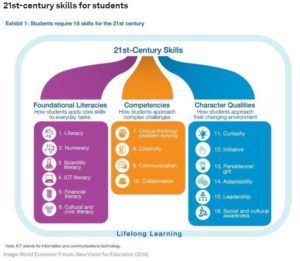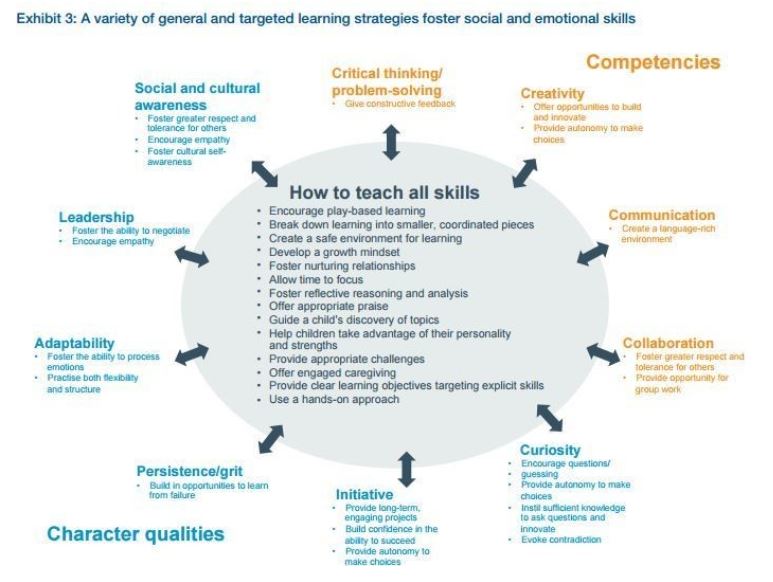
By William Van Zyl (2022)
Download the PDF for free: https://fivehousepublishing.com/product/introducing-the-arduino-uno-a-pioneering-digital-framework-to-prepare-students-for-21-st-century-problem-solving-five-journal-entries-a-critical-reflection-2/
Product details: 24 pages, 5551 words. APA referenced. 5 x journal entries – Implementation of the Arduino Uno – In a secondary school classroom.
Table of Contents
Abstract:
After reflecting on my own practice as a secondary school teacher in NZ, I have implemented the Arduino Uno. I have identified 21-st century skills required by employers (World Economic Forum, 2015): Solving real-life problems, collaboration, critical thinking, creativity, and communication. See the diagram below.
I have been critical of the curriculum I deliver in my classes with this new knowledge. Consequently, I have researched and designed an intervention for my classes. I share the journey in five separate journal entries in this article. APA referenced.
Included are the five journal entries:
- A critical evaluation during the implementation of the Arduino Uno – successes and challenges.
- A critical reflection on my leadership in a digital-collaborative-innovative context.
- A Critical reflection on what kaupapa Māori principles – and informed opportunities for digital and collaborative innovation – I have identified. My future focus.
- A critical reflection on my future leadership. Taking into account making changes in my digital and collaborative learning environment as a teacher.
- Systems thinking, making things, 3-D-software, competition, and wellbeing leadership.
Keywords and Key Phrases:
Solving real-life problems, 21-st century skills, collaboration, communication, creativity, Kaupapa Māori principles, Arduino Uno, microprocessor, wellbeing, electronics, digital technology, building circuits, C++ code, and leadership.
See the great article: 21-st Century Skills


Link to the excellent article: https://www.weforum.org/agenda/2016/03/21st-century-skills-future-jobs-students/

Download the PDF of the full article for free:
Excerpt: Journal Entry 1
Journal Entry 1: A critical evaluation of the successes and challenges I have encountered while implementing the Arduino.
“You need to figure out what kind of problem you are trying to solve before identifying a solution (The Creativity Post, 2017, n.p.).”
10 Ideas I have used to make my classroom more innovative (Schulman, 2018) – including additional ideas. A self-reflection.
- Mindset: I have allowed the prompts to question my own practice. Consequently, I have made many changes. I have used Wagner’s Five Essentials or Education for Innovation (Wagner, 2012). They are:
- Collaboration Versus Individual Achievement: Groupwork on the layout of the pods in class enhanced cooperation.
- Multidisciplinary Learning Versus Specialization: Students were challenged to search for solutions. In the process, they had to explore other subject areas (Science, Accounting, Business, Maths, and more)
- Trial and Error Versus Risk Avoidance: Students examined and tested the sensors to find solutions to their problems.
- Creating Versus Consuming: Sessions in class were directed towards creating solutions – a complete change to how we do things in class.
- Intrinsic Versus Extrinsic Motivation: Students developed a hunch and endeavoured to solve their hypotheses.
- Self-Reflection: I was prompted to be more critical and self-reflective by writing blog posts and producing podcasts on how to use sensors with the Arduino. Listening to the podcast provided me with the opportunity to give more depth to my innovation. My goal was to allow students to be more creative – and freer – to explore and collaborate.
- Ask Open-Ended Questions: Solving real-life problems requires developing good questions. The use of open-ended questions provides prompts.
- Create Flexible Learning Environments: For example, purchasing Arduino sets – allowing students to work together in small groups – improved collaboration – not a cookie-cutter approach). The environment was also conducive to Māori kaupapa principles and has improved learning for Māori students in class. Challenge to me: How would I structure and scaffold the learning for the senior students to quickly learn the basics of Arduino and how to use the Arduino to address sustainability issues (SDGs)?
- Personality Matters: ‘Create A Place for All Learners.’ For example, two 16-year-old students wanted to pull things apart and see what was inside. I have collected unused computers and other electronic devices for them to explore,
- Use Problem-Finding: Students were given the freedom to use the Arduino to explore problems they are interested in solving (A combination of individualism and collaboration).
- Let Students Take Risks and Fail: Give students the freedom to explore ambitious projects. Through trial and error, they learn by making mistakes. After all, a great way to learn is by making mistakes. Students are encouraged to think big.
- Consider A Flipped Classroom Model: I have used Google Classroom extensively (considering the Covid interruptions). All lessons and assessments are posted in advance to allow students to prepare for classes (Campillo-Ferrer & Miralles-Martínez, 2021).
- Invite Entrepreneurs and Innovators into The Classroom: I have focused on entrepreneurship and business opportunities to develop student solutions (Arduinos). For example, I have a year 13 student that loves electronics and computers. He has developed products that he is busy marketing and selling. He has shared his experiences in creating Apps and products to sell to businesses with students.
- Use The Design-Thinking Process (Arduino Uno – changed it to solving problems): I included a design brief for students. The intention was to get students to find relevant problems which they find interesting. The goal was to learn how to solve real-life problems. For example, solar power and smart-home technology (apps, sensors, and timers) can manage a sustainable house’s lights (LEDs).
Additionally, I have included:
- Action Research (Mutch, 2015): My research has prompted me to think about my own practice. I have made the changes: Allowing students to work together – Māori principle of shared responsibility and whanau (Spiller et al., 2020; White & Kaiwai, 2019).
- Computer programming and microprocessors: I have used the Waitomo Caves experience – and my new knowledge from the DCL course, including the Arduino Uno and sensors – to forge a new path for students to understand sensors and electronic design. I have also introduced microprocessor programming and breadboard circuits – using C++ computer language – to inspire students to explore and implement digital technology to solve problems. Students had to identify a real-life situation and design a solution (The Creativity Post, 2017). For example, automating lighting switches in homes saves energy (movement sensors to switch lights on and off). I have used the DCL resource on design: How to fly the design kite. Empathise, Define, Ideate, Prototype, Test, Reflect and Iterate (MindLab, 2022).
- Entrepreneurship and business models: I have introduced an entrepreneurial approach in brief development and design (Schulman, 2018). Made students aware of business opportunities, patents, marketing, and making profits. I have a year 13 student (Level 3) who is currently developing an electronics project which he plans to sell. Challenge: Building students’ confidence to share and collaborate in class and online. Challenge: In the collaborative environment, improving students’ design ideas, prototypes, final designs and establishing a deeper understanding of digital design, digital systems, and business opportunities are pretty challenging.
- Kaupapa Māori: I have developed my class collaboration techniques, including kaupapa Māori principles (Spiller et al., 2020; White & Kaiwai, 2019). Challenge: It took a while to get my head around the practical aspects of embedding kaupapa Māori into my lessons. See my more elaborate comments on these challenges in the kaupapa Māori section. Furthermore, I had to Include Māori words to frame and describe pedagogical content knowledge (Electronics terminology). Building a framework of keywords for Māori students took time and is ongoing.
- Action Research: I have identified areas that I could improve on in my teaching practice. All are included in this section. I have experimented with effective group work practices (Shulman, 2018; Mutch, 2005) in my Electronics classes.
- Leadership: I have critically evaluated my leadership skills to introduce change and manage change in my classroom. Implementing shepherd and lean leadership (Averin, 2020; Jenkins, 2017). For example, students create with the Arduino versus only consuming (Wagner, 2012).
- Collaborating outside my school: I have shared my innovation with the DCL enrolled teachers and practised collaboration online – developing my leadership outside of my own school (Wagner, 2012). For example: After consulting and collaborating with a co-student of DCL – a teacher friend whose challenge was to start Electronics at his secondary school this year as a new subject – we have shared and brainstormed about a possible way forward.
References:
Campillo-Ferrer, J.M.& Miralles-Martínez, P. (2021). Effectiveness of the flipped classroom model on students’ self-reported motivation and learning during the COVID-19 pandemic. Humanit Soc Sci Commun 8, 176 (2021). https://doi.org/10.1057/s41599-021-00860-4
Heinrich, S. & Kupers, R. (2019). “Complexity as a Big Idea for Secondary Education: Evaluating a Complex Systems Curriculum,” Systems Research and Behavioral Science, Wiley Blackwell, vol. 36(1), pages 100-110, February.
Kupers, R. (2018, February 9). Blog: A high school complexity curriculum by Roland Kupers. https://perspectivity.org/blog-a-high-school-complexity-curriculum-by-roland-kupers/
Mutch, C. (2005). Doing Educational Research: A Practitioner’s Guide to Getting Started. Wellington: NZCER Press.
Quote investigator. (2014). I Would Spend 55 Minutes Defining the Problem, and then Five Minutes Solving It. Rhttps://quoteinvestigator.com/2014/05/22/solve/#note-8929-2
Shulman, R. (2018, November 19). 10 Ways Educators Can Make Classrooms More Innovative. Forbes. https://www.forbes.com/sites/robynshulman/2018/11/19/10-ways-educators-can-makeclassrooms-more-innovative
The Creativity Post. (2017, September 07). Innovation As Problem-solving. Interview with Greg Satell, the author of Mapping Innovation: A playbook for Navigating a Disruptive Age.
The MindLab, 2021 – How to Fly the Design Thinking Kite. Retrieved from MindLab’s resources and DCL course (2021 – 2022).
Wagner, T. (2012). Calling All Innovators. Educational Leadership, 69(7), 66–69. E
I think this internet site has got some very superb info for everyone : D.
Hi Gonterman. Thanks for your comment – much appreciated. I am glad you are finding the website useful. All the best. Regards. William Van Zyl (Five House Publishing).